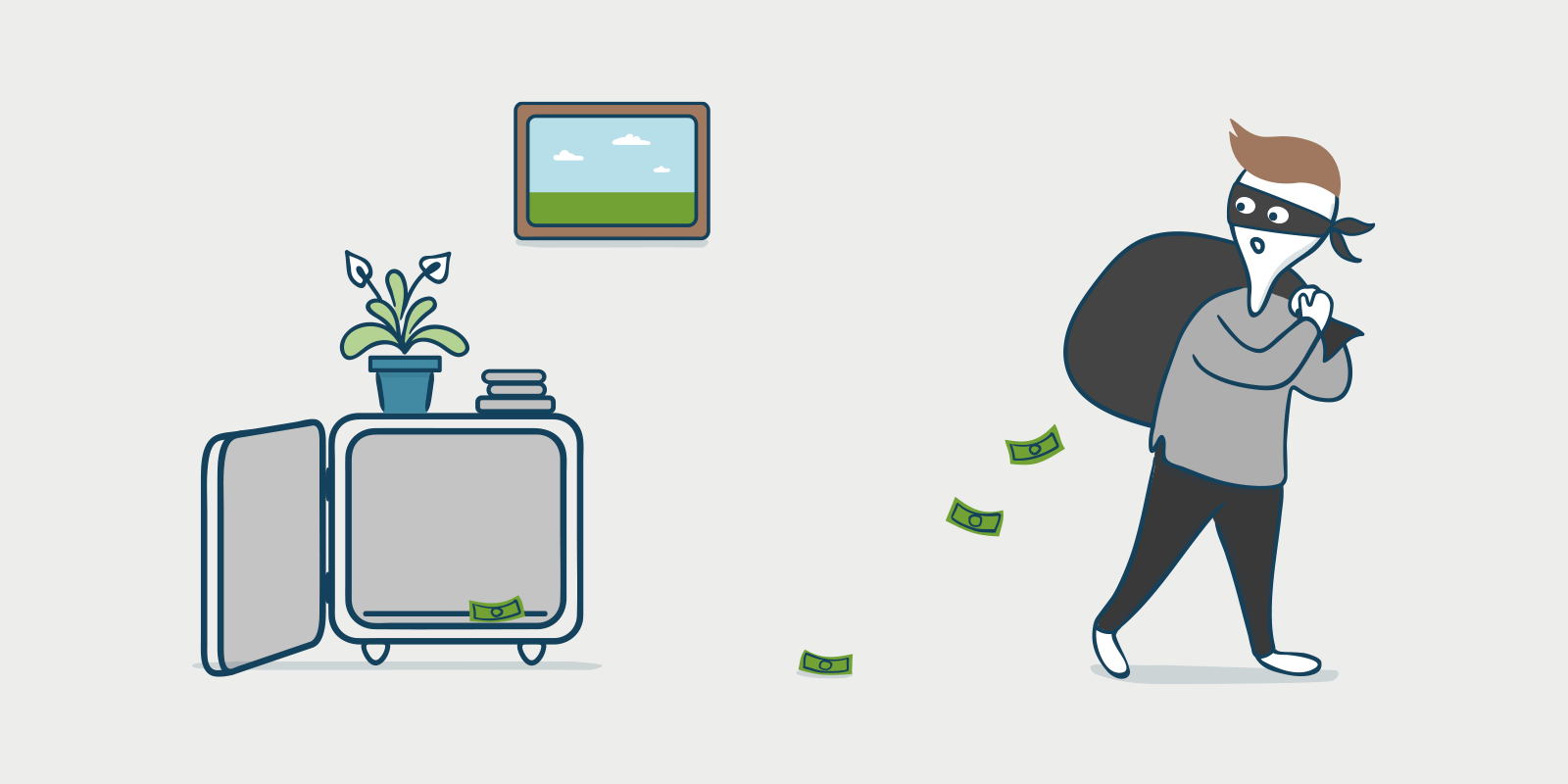
Did you know that England and Wales experienced 273,076 burglary cases in the year ending September 2023?
As a landlord, you want to protect your property and tenants. But how do you secure a rental from threats like burglary, fire, water damage, and unruly residents?
Don’t sweat it; we’ve got your back. Join us in this read, where we explain how to secure a rental property. We’ll walk through essential tips to safeguard your BTL property so you can sleep easy at night, knowing your rental is protected.
Securing property against burglary
Burglary is a landlord’s worst nightmare. According to recent statistics, some UK regions experience up to 16 burglaries per 1,000 households, resulting in billions of pounds of losses yearly. As a landlord, it’s crucial to take measures to reduce the risks of break-ins to protect your property and tenants.
Consider the following:
- Install sturdy locks.
- Install an alarm system.
- Secure access points.
- Do regular inspections.
1. Install sturdy locks
The first line of defence is installing high-quality security locks on all exterior doors. Keyless locks are more secure since they can’t be copied, and they usually feature advanced security technology. For even more security, consider installing steel doors or security doors with built-in locks. It may cost more upfront, but it will give you peace of mind and reduce insurance premiums in the long run.
2. Install an alarm system
Alarm systems are highly effective deterrents against burglars. Choose between a monitored system that alerts emergency responders or a standalone system with loud sirens. For the most comprehensive protection, install motion-activated lights, security cameras, and window sensors in addition to door sensors. For empty properties, install a smart lighting system that simulates occupancy to deter burglars.
3. Secure access points
Check that all windows, skylights, crawl space entries, and the attic are securely closed and locked. Burglars often enter through these access points. You should also trim back shrubbery and trees around the building so intruders can’t easily hide.
4. Do regular inspections
As a landlord, you or your estate agent should do periodic inspections of the property to check for any security vulnerabilities. Look for signs of attempted break-ins, like pry marks around locks or broken windows. Trim back shrubbery and plants that could conceal intruders and check that all locks and security equipment are functioning properly. It’s also a good idea to change the locks when there’s a change in tenants — always inform your estate agents to do the same.
By taking a multi-pronged approach to security with sturdy locks, a reliable alarm system, and frequent inspections, you can safeguard your rental property and give tenants peace of mind. While there’s no way to eliminate the risk of burglary, these practical steps will help deter criminals and reduce the opportunities for break-ins.
Another way you can secure your property is to ensure protection against fire damage. Continue reading to learn how.
Protecting rentals from fire damage
As a landlord, a fire tearing through your property is an experience you will never hope to have in the rental market. However, a staggering 25,972 dwelling fires were reported in England in the year ending September 2023, often resulting in deaths and injuries.
To secure rental properties and tenants from fire outbreaks, consider the following:
- Install smoke detectors.
- Check electrical systems.
- Ban unsafe items.
- Educate tenants.
1. Install smoke detectors
Smoke detectors are your first line of defence and are required by law in most areas for a new property. Place them on every level of the home, especially near bedrooms. Test them monthly and change the batteries every 6–12 months.
2. Check electrical systems
Faulty wiring is a leading cause of residential fires. To prevent them from happening, inspect the electrical panel, outlets, and any wiring you have access to. Replace or repair anything that looks worn or damaged, and consider hiring an electrician to inspect the entire system. Also, ensure you meet your landlord certificate obligations, like obtaining a domestic electrical installation certificate.
3. Ban unsafe items
Prohibit items like space heaters, deep fryers, and charcoal grills that can pose a fire risk. Be cautious about allowing candles or wood-burning fireplaces. You can include these banned items in the current tenancy agreement—via the Rentila software—to enforce compliance.
4. Educate tenants
Explain fire safety measures and evacuation plans to all tenants. Walk them through using fire extinguishers, testing smoke detectors, and calling 999 in an emergency. Also, post emergency contact details and procedures where they are easily visible.
Protecting your investment from the devastating effects of fire is well worth the time and money. Implementing these practical safeguards will give you more peace of mind and help ensure many safe, profitable years as a landlord. Water is another leading cause of property damage we’d like to address — check out the below section, where we share some practical measures to protect your BTL properties from water damage.
Preventing water damage in rental units
Water damage is a big risk for rental property owners. According to a report by the Association of British Insurers, water damage claims make up nearly 25% of all homeowners insurance claims. As a landlord, the last thing you want is a call from your tenants saying there’s water leaking from the ceiling or flooding in the basement.
Take the following preventative steps to avoid costly water damage repairs:
- Install water sensors.
- Inspect plumbing and seals regularly.
- Educate tenants on emergency procedures.
1. Install water sensors
For optimum security, rental properties should be fitted with water sensors. These are devices you place in areas prone to leaks, like near water heaters, washing machines, and basements. They detect the presence of water and can alert you immediately so you can address the issue. Many smart water sensors connect to your phone and will send you an alert as soon as they detect water. These affordable devices can help minimise damage from small, slow leaks or sudden bursts like a pipe bursting.
2. Inspect plumbing and seals regularly
Take the time to check under sinks, behind toilets, water heaters, and anywhere else there are water lines or drains. Look for any signs of drips, leaks, or water damage. Check that seals and washers are in good shape and replace them if there are any signs of cracking or wear. It’s also a good idea to flush water heaters annually to prevent sediment buildup that could lead to corrosion.
3. Educate tenants on emergency procedures
Make sure your tenants know where the main water shutoff is located in case of a plumbing emergency. Show them how to turn off the water in the event of flooding or a burst pipe. Let them know who to contact for emergency plumbing repairs both during and after business hours. The faster the water can be turned off, the less damage there will be.
An ounce of prevention is worth a pound of cure, as the adage goes. Keeping a close eye out for leaks and educating your tenants will help make sure the only water in your rental units is the water that’s supposed to be there. One last way to secure your BTL property is by protecting it from unruly tenants — more info on this below!
Dealing with unruly tenants
One of the biggest headaches for landlords is dealing with troublesome tenants. Landlord possession claims increased by 19% between the short period of 2022 to 2023. As a landlord, it’s important to take action quickly, securing your property against damage, legal issues, and loss of rent.
Here are some tips to consider:
- Screen tenants thoroughly.
- Respond to issues promptly.
- Know your rights and responsibilities.
- Pursue eviction as a last resort.
1. Screen tenants thoroughly
The best way to avoid problem tenants is by vetting applicants carefully to ensure you’re only accepting the most attractive renters. Run credit and background checks, check references, contact their previous landlord if possible, confirm their identity using their passport or driving licence, and meet with prospective tenants in person instead of leaving it to a letting agent. Look for any red flags indicating their unsuitability for your rental home.
While this extra diligence upfront requires more work, it will save you trouble later on. You can also consider using the help of letting agents to save time.
2. Respond to issues promptly
If you do end up with an unruly tenant, take action right away. Don’t ignore warning signs like excessive noise complaints, property damage, unpaid rent, and other things tenants are not allowed to do while renting. Talk to the tenant as soon as possible to make the issue known. You may be able to resolve things through a conversation by setting clear rules and expectations. However, if the problem continues, you’ll need to take further steps to remedy the situation.
3. Know your rights and responsibilities
Familiarise yourself with landlord and tenant laws in your area. This will allow you to properly handle unruly tenants while avoiding legal trouble yourself. You have the right to issue warnings, charge fees for damages, and pursue eviction for lease violations. However, you must follow the correct procedures for notifying tenants and allowing them time to remedy issues. Always have your paperwork ready, and work with a legal professional to ensure you stay within the law.
4. Pursue eviction as a last resort
Evicting a tenant in the UK is a difficult and time-consuming process, so only do so when other options have been exhausted. Issue clear written warnings first, with deadlines for the tenant to correct their behaviour. If they fail to improve, you may need to start the eviction process through the court system.
Keep records of all correspondence and issues in case you end up in a legal dispute with the tenant.
Eviction should really be a last line of defence, but sometimes, it’s necessary to remove a troublesome tenant from the property. Remember to change the lock of your property once a tenant is evicted or when their lease expires. It’s safer to ensure they don’t have access to the apartment any longer.
Even the most responsible landlords encounter issues at times. Therefore, have systems in place ahead of time so you can resolve any tenant issues efficiently while avoiding headaches or legal trouble. We recommend trying out our cloud-based property management software, Rentila. It allows you to keep a good record of your tenant’s data and ensure compliance and efficient property management.
Frequently asked questions
How can I make my rental house more secure?
To make your rental house more secure, consider installing security cameras and exterior lights for visibility. Set up automatic timers to simulate occupancy, secure patio doors, and fit window locks and alarms. Keyless locks can enhance entry security, while shrubs act as natural deterrents. Lastly, secure landlord insurance for added protection.
How do you secure a rental window?
To secure a rental window, start by installing robust window locks and ensure tenants know where the keys are. For additional security, consider fitting alarms on each window. This not only deters potential intruders but also provides tenants with peace of mind that their home is safeguarded.
How do I protect the walls in my rental property?
To protect the walls in your rental property, consider installing magnetic wallcoverings — they are a damage-free way for tenants to customise their space. They’re easily applied, just like wallpaper, and allow tenants to hang pictures, shelves, and other decor without leaving a trace when it’s time to move out.
How to secure a rental property?: things to remember
- Install quality locks, doors, and windows that can’t be easily broken into.
- Install safety systems like fire and water sensors.
- Educate tenants on the importance of safety and how to navigate a hazard.
- Be extremely thorough when screening potential tenants.
- Always change the locks between tenants to ensure only the new occupants have access.
- Make sure you have proper insurance coverage for your rental property.
- Conduct routine inspections of your rental property, especially for longer-term tenants.
- Make an effort to foster positive relationships with your tenants.



 Protect the environment. Reduce paper consumption and help save the trees as well as save money at the same time.
Protect the environment. Reduce paper consumption and help save the trees as well as save money at the same time. 
